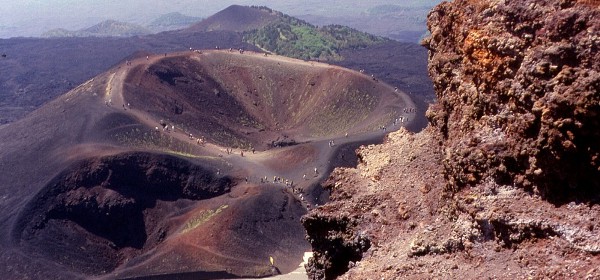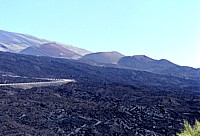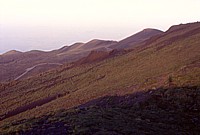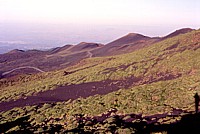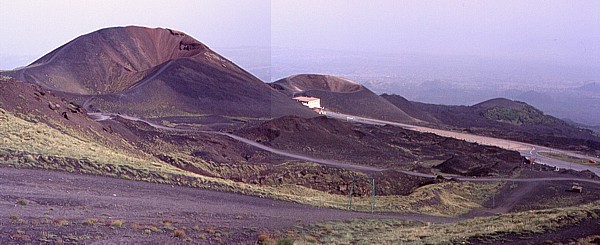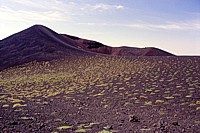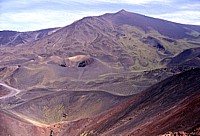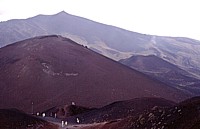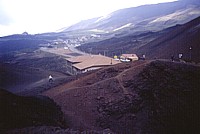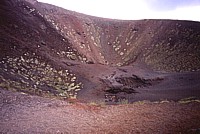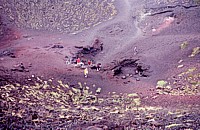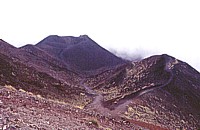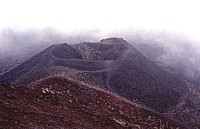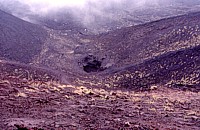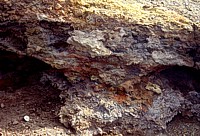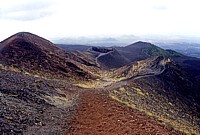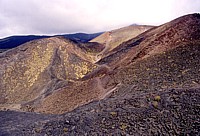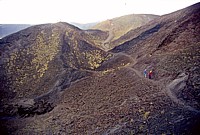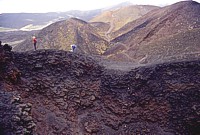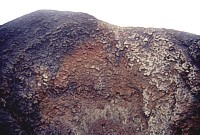| Etna
index |
||
| Geology | Geological history | Cones and craters |
| Eruptive characteristics | Eruptions before 1971 | Eruptions since 1971 |
| Etna and Man | References | Web sites |
| Weather forecasts | FAQ | Latest news |
Mamma
Etna's countless children
Monti Silvestri (1892 eruption)
S flank, 15.005463° E, 37.700246° N
Summit elevation: 1997 m (M. Silvestri superiore)
![]()
For
many visitors they are Etna: the conspicuous, colorful pyroclastic
cones and craters that lie only a few hundred meters away from the cluster
of tourist facilities of the Rifugio Sapienza area, named after one of
the pioneers of Italian volcanology, Silvestri. Hundreds of thousands
of tourists per year clamber about on these craters to live the suggestive
experience of being on a volcano and look into its craters - although
they are still about 1300 m below the true summit craters of that volcano.
But these craters can be conveniently reached by car (and buses), leaving
just a short walk to the most accessible of them (Monte Silvestri inferiore).
As a consequence of the countless visits the craters are somewhat degraded,
although they still represent one of the more spectacular cases of a cluster
of flank cones at Etna.
The Monti Silvestri were formed during a large flank eruption that lasted
from 8 July until 29 December 1892 and was probably the second largest
flank eruption of Etna since 1669 (with a lava volume of 145
x 106 m3)
surpassed only by the 1991-1993 eruption. Yet it did little damage, because
its lavas covered mainly lava flows of previous eruptions (1763, 1766,
1886) and remained more distant from the town of Nicolosi than those of
1766 and 1886. The eruption produced heavy ash falls, probably similar
to those of the 2002-2003 eruption, but at that time the (much smaller)
human community living around the volcano was considerably less sophisticated
and thus less vulnerable than it is today.
Actually the Monti Silvestri consist of a quite large number of pyroclastic
edifices, in part of notable dimensions, and some of them even bearing
different names to those of the main cones, as Monte Nero, the southernmost
of the major pyroclastic cones. Others are simply nameless, and some lie
away from the trend of the main eruptive fissure on which the largest
cones were built, clear evidence for the complexity of the eruption that
gave birth to them. The largest of the cones, Monte Silvestri superiore,
is strongly asymmetric, with two craters, the more northerly of which
has its north rim standing only a few meters above the surrounding surface
(this rim was actually surmounted by a small tongue of lava of the 2001
eruption). In contrast, the southeastern portion of Monte Silvestri superiore
rises 100 m above its base, and a serious climb is required to enjoy the
commanding view onto the lower cones in the southern part of the row of
cones.
Monte Silvestri inferiore, about 0.4 km south of its larger neighbor,
rises to a height of 1912 m and has an impressive main crater whose bottom
is pierced by a pit about 8 m wide (in state of constant degradation due
to the numerous visitors trampling around on it); a second, smaller crater
with near vertical walls lies at its NE side. Further to the south rises
the steep-sided cone of Monte Nero (a name used for several flank cones
of Etna, but in this case truly justified), reaching a summit height of
1880 m. At its northern and southern bases lie two small pits, and lava
outflow apparently mainly occurred from the latter of these.
In the upper portion of the 1892 eruptive system there is another conspicuous
(but nameless) crater surrounded by a low pyroclastic cone, lying about
0.4 km from Monte Silvestri Superiore. A second, less expressed row of
eruptive vents formed along an eruptive fissure running parallel to the
main fissure, about 0.25 km to the west, characterized by low spatter
ramparts. The activity there was probably mainly effusive.
The photographs on this page were taken mainly during three extended visits
to the Monti Silvestri, on 24 May 1998, on 8 September 1999 and in mid-September
2001. Those taken before the 2001 eruption have become documents of a
landscape that now looks somewhat different due to that eruption.
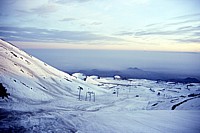 |
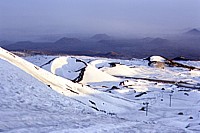 |
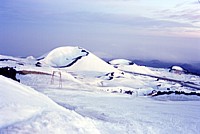 |
The
Monti Silvestri in a winter fairy tale (8 February 2000). The photos
were taken at sunset while descending the ski track that existed
on the western side of the Montagnola (whose slope can be seen in
the left and center images at left) until the 2001 eruption. Left
image shows the conspicuous twin-peaked silhouette of the Monti
Rossi (formed during the 1669 eruption)
in the distance; more of the flank cones on the south-southeast
flank of Etna are seen in the background of the center image (from
left to right: Monte Difeso, Monte Arso, Mompeloso [with the low
Monte Gervasi before it], Monte Salto del Cane [seen somewhat closer],
Monte S. Nicola, Monte Serra Pizzuta, a snow-covered nameless cone,
and the eastern half of the Monti Rossi at extreme right). Center
and right photos are slightly blurred to long exposure |
||
Copyright © Boris Behncke, "Italy's Volcanoes: The Cradle of Volcanology"
Page set up on 14 December 2003, last modified on 14 March 2004

